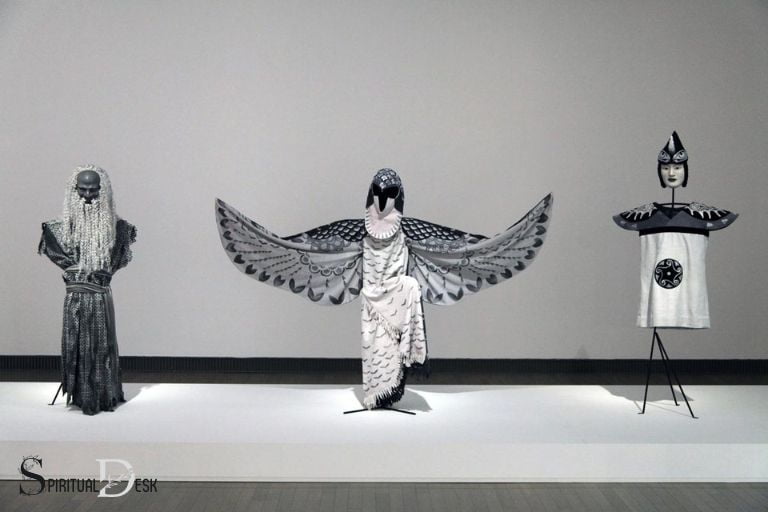Spiritualism in at the Hawk’s Well: Inclusion & Infusion!
“Spiritualism in At the Hawk’s Well” refers to the inclusion and infusion of Eastern spiritual elements in W.B.
In the play, he depicts a spiritual journey in which a traveler must confront the guardian of the well in order to gain knowledge and wisdom.
In “At the Hawk’s Well”, Yeats combines Irish mythology with Eastern spirituality to explore the concepts of transience and eternal life.
Yeats uses the character of the Old Man, who waits by the Hawk�s Well for the water of immortality, to symbolize humanity’s futile quest for immortality.
The Guardian of the Well, a symbol of spiritual enlightenment, only allows those deemed worthy to drink from the well.
Overall, The Hawk’s Well is a spiritual journey that explores the idea of facing one’s fears in order to gain spiritual knowledge and wisdom.
The play speaks to timeless truths and holds symbolism that has become a part of modern spiritual culture.
11 Aspects About Spiritualism in at the Hawk�s Well
| Aspect | Description |
| Playwright | William Butler Yeats |
| Publication Year | 1917 |
| Spiritual Elements | Symbolic journeys, mythical creatures, presence of spirits |
| Key Characters | Old Man (a spiritual figure), Young Man (a hero), Hawk |
| Major Spiritual Theme | Quest for inner-self and wisdom |
| Cultural Influence | Inspired by Japanese Noh theater and Irish mythology |
| Spiritual Imagery | Well symbolizes spiritual wisdom, Hawk represents spiritual guardian |
| Dramatic Technique | Use of dance and masks, minimalistic set |
| Spiritual Influence | Combination of Oriental and Western spiritual beliefs |
| Symbolism | Yeats uses symbolism to indicate the journey of self-discovery and attainment of knowledge |
| Relevance of Spiritualism | Ties the themes of personal choice, fate, and spiritualism to illustrate the struggle for spiritual enlightenment |
Key Takeaway

Five Facts About: Spiritualism in at the Hawk�s Well
Understanding The Historical Background
Spiritualism In At The Hawk’s Well: Understanding The Historical Background
Significance Of W.B. Yeats
- W.b. Yeats, a renowned irish poet and playwright, played a pivotal role in introducing and promoting spiritualism in his work, including the play “at the hawk’s well.”
- Yeats was deeply influenced by the occult, mysticism, and celtic folklore, which he believed offered a deeper understanding of human existence.
- “at the hawk’s well” reflects yeats’ exploration of themes like the quest for immortality, the lure of the supernatural, and the dichotomy between the physical and the spiritual realms.
Cultural Context During The Time Of Creation
- “at the hawk’s well” was written in 1916, a time when europe and ireland were experiencing significant socio-political changes.
- The play can be seen as a response to the turbulent atmosphere, where people sought solace and escape in spiritual and mystical ideologies.
- Irish nationalism and the revival of celtic culture influenced yeats’ work, making “at the hawk’s well” a reflection of nationalistic sentiment and a celebration of ireland’s rich cultural heritage.
Key Themes Explored In “At The Hawk’s Well”
- The quest for eternal youth: The play revolves around the characters’ pursuit of a mythical well that promises immortality and eternal youth.
- The conflict between the mortal and the immortal: It delves into the tension between the transience of human life and the timeless nature of the spiritual realm.
- The power of ritual and incantation: “at the hawk’s well” explores the potency of ancient rituals and magical chants in connecting with spiritual forces.
- The ambiguity of reality: The play blurs the lines between illusion and reality, tempting the audience to question the nature of existence and the validity of the material world.
- The search for meaning and transcendence: It delves into the human desire for higher purpose, transcendence, and a connection with the divine.
Influence On Modern Spiritualist Movements
- The themes and ideas present in “at the hawk’s well” align with the broader spiritualist movements at the time.
- The play’s engagement with mysticism, occultism, and supernatural phenomena resonates with various esoteric and spiritual philosophies.
- Yeats’ exploration of spiritualism in his work has had a lasting impact on subsequent generations of occultists, poets, and artists.
While the world around yeats underwent significant changes during the time of writing “at the hawk’s well,” his exploration of spiritualism and its cultural context still holds relevance today.
Through his poetic and theatrical craftsmanship, yeats’s work continues to inspire and provoke contemplation on the nature of existence, the pursuit of immortality, and the significance of the spiritual realms.
The Plot Of At The Hawk�s Well
The Plot Of “At The Hawk’s Well”
In w. b. Yeats’ iconic play, “at the hawk’s well,” the plot revolves around a timeless theme of human longing for spiritual enlightenment and the search for eternal youth.
Set in ancient japan, this symbolic masterpiece explores the transformative journey of a nameless pilgrim who seeks rejuvenation from a legendary well guarded by a hawk. Let’s delve into the plot of this captivating play.
Introduction To The Plot
The play begins with a chorus describing the well and its mystical powers, setting the stage for the protagonist’s quest.
The plot unfolds through a series of encounters and conversations between the pilgrim and the hawk, as well as other key characters.
Key Characters And Their Roles
The protagonist:
- The nameless pilgrim embarks on a quest to drink from the hawk’s well, driven by a deep desire for spiritual rejuvenation and eternal youth.
- He symbolizes the human quest for immortality and the desire to transcend the limitations of mortal existence.
The hawk:
- The hawk guards the well, offering both protection and challenge to those who seek its waters.
- It represents the spiritual realm and the guardian of wisdom and enlightenment.
The chorus:
- The chorus serves as a narrative voice, providing context and commentary on the events happening in the play.
- They shift the perspective between the spiritual and the human, giving insights into the motivations and emotions of the characters.
The old man:
- The old man, encountered by the pilgrim on his journey, guides and advises him on his path towards the hawk’s well.
- He represents wisdom and experience, offering valuable insights and warnings along the way.
The girl:
- The girl is a fleeting presence in the play, captivating the pilgrim with her beauty and youth.
- She embodies the ephemeral nature of human desire and serves as a reminder of the protagonist’s ultimate goal.
The plot of “at the hawk’s well” is a thought-provoking exploration of human longing and the pursuit of spiritual enlightenment.
Through the interactions between the pilgrim, the hawk, and other key characters, w. b. Yeats delves into timeless themes of immortality, wisdom, and the transient nature of human existence.
This play continues to captivate audiences with its introspective narrative and profound symbolism.
Examining The Spiritual Themes
Located in the heart of ireland, the play “at the hawk’s well” by w. b. Yeats delves into the realm of spirituality and metaphysics.
Through symbolism and the representation of a spiritual journey, the play explores profound themes that captivate the audience.
In this section, we will examine the spiritual motifs and the significance they hold within the context of the play.
Symbolism And Its Role:
- The hawk: Symbolizing the soul’s search for transcendence, the hawk serves as a central symbol in the play. Its graceful and ethereal presence represents the desire to break free from the confines of earthly existence.
- The well: Acting as a metaphorical gateway to spiritual enlightenment, the well embodies the source of healing and rejuvenation for the characters. It symbolizes the connection between the mortal world and the realm of the divine.
- The cloak: A symbol of protection and transformation, the cloak worn by cuchulain represents the journey of the soul. As the play progresses, the cloak undergoes various changes, reflecting the protagonist’s evolution on his spiritual quest.
Representation Of Spiritual Journey:
- Redemption and transformation: The characters in “at the hawk’s well” embark on a journey of self-discovery and transformation. Through their encounters with the hawk and their exploration of the well, they seek redemption from their mundane existence and strive for a higher state of consciousness.
- The quest for immortality: Immortality, in the context of the play, is not merely a physical state but a spiritual one. The characters yearn for everlasting life through spiritual enlightenment and the transcendence of human limitations.
- The battle within: The spiritual journey in the play is not devoid of internal conflicts. The characters face their inner demons and grapple with personal struggles, reflecting the universal human experience of overcoming obstacles on the path to spiritual growth.
Through symbolism and the portrayal of a transformative spiritual journey, “at the hawk’s well” weaves a compelling narrative that explores the depths of the human soul.
The play serves as a reminder of our innate desires for transcendence, redemption, and the constant search for meaning in our lives.
Influence Of Japanese Noh Theatre
Spiritualism in at the hawk’s well is greatly influenced by japanese noh theatre. The incorporation of noh elements enhances the mystical and otherworldly aspects of the play.
Here, we will explore the key points of this influence and how noh theatre breathes life into at the hawk’s well.
Introduction To Noh Theatre
Noh theatre is a traditional japanese form of theater that dates back to the 14th century. It combines elements of dance, music, and drama to create a unique and spiritual experience.
The following points highlight the key aspects of noh theatre:
- Rooted in japanese folklore and mythology, noh theatre often portrays supernatural and spiritual themes.
- Key features of noh performances include slow, stylized movements, elaborate costumes, and masks to represent different characters.
- Noh music, known as hayashi, consists of percussion instruments and flute, creating a haunting and ethereal atmosphere.
Incorporation Of Noh Elements In At The Hawk’s Well
The influence of noh theatre can be seen in at the hawk’s well through several notable elements.
Let’s delve into these aspects:
- Symbolism: Noh theatre heavily relies on symbolic gestures and imagery to convey meaning. Similarly, at the hawk’s well utilizes symbols, such as the hawk or the well, to represent deeper spiritual concepts.
- Ritualistic movements: Noh performances feature deliberate and precise movements, which are mimicked in at the hawk’s well. The characters’ actions are carefully choreographed, adding an air of sacredness and ritual to the play.
- Chorus: In noh theatre, a chorus often accompanies the actors, providing narration and commentary. Similarly, at the hawk’s well incorporates a chorus that guides the audience through the spiritual journey, offering insight into the characters’ inner thoughts and emotions.
- Masks: Noh masks are essential in portraying different characters and their emotions. Similarly, at the hawk’s well uses masks to evoke a sense of mystery and otherworldliness, enhancing the transcendent nature of the play.
The influence of japanese noh theatre on at the hawk’s well is evident in its symbolism, ritualistic movements, chorus, and use of masks.
These elements transport the audience into a spiritual realm, immersing them in a world where the mystical and the real coexist harmoniously.
Exploring The Impact And Legacy
Spiritualism In At The Hawk’S Well
At the hawk’s well is a one-act play written by william butler yeats in 1916.
It is known for its incorporation of spiritual themes and symbolism, which had a profound impact on both the critical reception of the play and its influence on subsequent works.
Critical Reception And Analysis
- The play initially received mixed reviews from critics, with some praising its poetic qualities and spiritual themes, while others found it to be confusing and inaccessible.
- Despite the mixed reception, at the hawk’s well is now considered a pivotal work in yeats’ career and has garnered significant attention from literary scholars and theatre enthusiasts alike.
- Critics have praised the play’s exploration of themes such as the search for immortality and the role of art in transcending the limitations of the physical world.
- The play’s use of symbolism, particularly the character of the hawk, has been widely analyzed for its representation of the spiritual journey and the pursuit of enlightenment.
- Scholars have also examined the influence of japanese noh theatre on the play, noting similarities in the use of minimalistic settings and ritualistic performances.
Influence On Subsequent Works
- The spiritual themes and symbolism in at the hawk’s well have had a lasting impact on the development of modernist drama and poetry.
- Playwrights and poets such as t.s. Eliot and samuel beckett were influenced by yeats’ exploration of the spiritual realm, incorporating similar themes and techniques into their own works.
- The play’s emphasis on the inner journey and the search for meaning in life has resonated with audiences and continues to inspire contemporary playwrights.
- The use of symbolism in at the hawk’s well has also influenced visual artists, who have incorporated similar techniques in their paintings and sculptures.
- The play’s exploration of the supernatural and the spiritual has contributed to the broader cultural fascination with mysticism and the occult in the 20th century.
At the hawk’s well’s incorporation of spiritualism has left a significant impact on both its critical reception and its influence on subsequent works.
Its exploration of spiritual themes and use of symbolism have captivated audiences and continue to inspire artists and writers to this day.
FAQ For Spiritualism In At The Hawk�s Well
What Is The Significance Of Spiritualism In “At The Hawk’s Well”?
The spiritualism in “at the hawk’s well” explores the human desire for transcendence and the search for truth.
How Does “At The Hawk’s Well” Explore Spiritual Themes?
“at the hawk’s well” delves into spiritual themes through poetic language, symbolic imagery, and mythical storytelling.
What Is The Connection Between Spirituality And The Characters In The Play?
The characters in “at the hawk’s well” embody different aspects of spirituality, reflecting the universal yearning for enlightenment.
How Does “At The Hawk’s Well” Portray The Quest For Spiritual Fulfillment?
The play portrays the quest for spiritual fulfillment as an arduous journey filled with challenges, temptations, and self-discovery.
What Can We Learn From The Spiritual Lessons In “At The Hawk’s Well”?
The spiritual lessons in “at the hawk’s well” remind us of the importance of self-reflection, the pursuit of truth, and the transformative power of spiritual experiences.
Conclusion
To summarize, “the hawk�s well” is a mesmerizing play that explores the depths of spiritualism.
Through vivid storytelling and captivating characters, yeats delves into the profound longing for transcendence and the search for meaning that resides within each of us.
The play’s themes of mystical encounters and the quest for the sacred resonate with audiences, reminding us of the enduring fascination with the supernatural.
The symbolism employed throughout the play adds to its mystique, as it invites us to contemplate the boundaries between the physical and spiritual realms.
As we immerse ourselves in the ethereal world of “the hawk�s well,” we are reminded of the universal human yearning for connection to something beyond ourselves.
This timeless piece continues to captivate and inspire, offering a glimpse into the realm of spiritualism and a profound exploration of the human spirit.
Bonus: Spiritualism in at the Hawk�s Well
What is Spiritualism?
Spiritualism is a belief system that revolves around the idea that the human soul can live on after death, and that communication with the dead is possible.
Spiritualists believe in reincarnation and often hold seances in order to contact deceased loved ones.
Some people may consult spiritualists for advice or guidance, while others simply enjoy the experience of communicating with the other side.
What are the Beliefs of Spiritualism?
Spiritualism is a belief system that holds that there is communication between the physical and spiritual worlds.
Spiritualists believe that spirits of the dead can and do communicate with the living and that they can be contacted through mediums. There are a number of core beliefs that are held by spiritualists.
These include:
What is the History of Spiritualism?
Spiritualism is a religious movement based on the belief that the spirits of the dead can communicate with the living.
Its origins date back to the early 19th century when a group of people in New York state began communicating with what they believed were the spirits of Native Americans.
The movement quickly spread to other parts of the United States and then to Europe.
By the 1850s, there were more than 10,000 spiritualist churches in America.
Among those who embraced spiritualism was the noted writer and lecturer Harriet Beecher Stowe, whose book “Uncle Tom’s Cabin” helped fuel abolitionist sentiment in pre-Civil War America.
During its heyday in the late 19th century, spiritualism attracted such notable believers as Mary Todd Lincoln, wife of President Abraham Lincoln; author Sir Arthur Conan Doyle; and scientist Thomas Edison.
But it also drew criticism from skeptics who dismissed it as a hoax or a fraud. Despite its detractors, spiritualism remained popular into the 20th century.
Who were Some of the Most Famous Spiritualists?
One of the most famous spiritualists was Emanuel Swedenborg. He was a Swedish scientist, philosopher, and theologian who claimed to have visions of the afterlife. Another famous spiritualist was Allan Kardec.
He was a French educator and author who wrote The Spirits’ Book, which is considered to be one of the most important texts in Spiritism.






